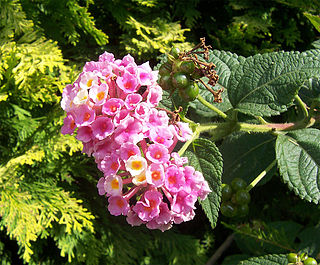
The Verbenaceae — the verbena family or vervain family — are a family of mainly tropical flowering plants. It contains trees, shrubs, and herbs notable for heads, spikes, or clusters of small flowers, many of which have an aromatic smell.

Verbena (,), also known as vervain or verveine, is a genus in the family Verbenaceae. It contains about 150 species of annual and perennial herbaceous or semi-woody flowering plants. The majority of the species are native to the Americas and Asia; however, Verbena officinalis, the common vervain or common verbena, is the type species, and native to Europe.

Verbena officinalis, the common vervain or common verbena, is a perennial herb native to Europe. It grows up to 70 cm high, with an upright habitus. The lobed leaves are toothed, and the delicate spikes hold clusters of two-lipped mauve flowers.

Verbena brasiliensis, the Brazilian verbena or Brazilian vervain, is a flowering plant species from the vervain family (Verbenaceae). It is native to parts of South America, namely Brazil, but has spread its range in recent times and has occasionally become an invasive weed. It is an annual plant with purple flowers, and it has been introduced outside of its native range as an ornamental plant, and is now largely considered an invasive weed in these regions.

Glandularia, common name mock vervain or mock verbena, is a genus of annual and perennial herbaceous flowering plants in the family Verbenaceae. They are native to the Americas.

Verbena bonariensis, the purpletop vervain, clustertop vervain, Argentinian vervain, tall verbena or pretty verbena, is a member of the verbena family cultivated as a flowering annual or herbaceous perennial plant. In USA horticulture, it is also known by the ambiguous names purpletop and South American vervain. For the misapplication "Brazilian verbena" see below.

Verbena urticifolia, known as nettle-leaved vervain or white vervain, is a herbaceous plant in the vervain family (Verbenaceae). It belongs to the "true" vervains of genus Verbena.

Verbena hastata, the American vervain, blue vervain or swamp verbena, is a flowering plant in the vervain family Verbenaceae. It is a perennial herbaceous plant with opposite, simple leaves which have double-serrate margins, borne on stiffly erect, branching square stems. The purple flowers appear in summer. This is a common plant that occurs across North America. It is hardy and drought resistant.

Verbena bracteata is a species of verbena known by the common names bracted vervain, bigbract verbena, prostrate vervain, and carpet vervain. It is native to North America where it is widespread, occurring throughout the continent except for northern Canada and southern Mexico. It occurs in many types of habitat, especially disturbed areas. It typically blooms between the months of May and October. This annual or biennial herb produces several hairy, spreading stems up to 30 centimeters long forming a low mat on the ground. The hairy leaves are toothed or lobed. The inflorescence is a spike of flowers which is dense with long, pointed, leaflike bracts each up to 8 millimeters long. Each small tubular flower is about half a centimeter wide and white to pale purple in color.

Glandularia gooddingii is a species of flowering plant in the verbena family known by the common name southwestern mock vervain. It is native to the southwestern United States and northern Mexico, where it occurs in sandy and rocky desert habitat. It is a perennial herb producing several hairy, decumbent to erect stems up to 45 centimeters long. The hairy leaves are generally divided at the base into a few lobes, which are edged with large teeth or small lobes. The plant blooms in large, dense, head-like spikes of many flowers. Each flower has a calyx of hairy sepals and a pale purple-blue corolla up to 1.4 centimeters long.

Glandularia pulchella is a species of flowering plant in the verbena family known by the common name South American mock vervain. It is native to Brazil, Argentina, and Uruguay, and it is present elsewhere as an introduced species and roadside weed. It is an annual or perennial herb producing one or more stems growing decumbent to erect in form and hairy to hairless in texture. The rough-haired leaves are divided deeply into lobes. The inflorescence is a dense, headlike spike of many flowers up to 1.5 centimeters wide. Each flower corolla is up to 1.4 centimeters wide and white to purple in color.

Verbena rigida, known as slender vervain or tuberous vervain, is a flowering herbaceous perennial plant in the family Verbenaceae. It is native to Brazil and Argentina, and is not fully hardy in temperate climates, where consequently it is grown from seed as an annual.

Verbena simplex, commonly known as narrowleaf vervain, is an herbaceous perennial plant in the verbena family. It is native to eastern North America where it is found in open, dry, habitats on calcareous soil. It is tolerant of disturbance, and is often seen in pastures and roadsides with sparse vegetation.

Verbena stricta also known as hoary verbena or hoary vervain, is a small purple wildflower native to a large region of the central United States.
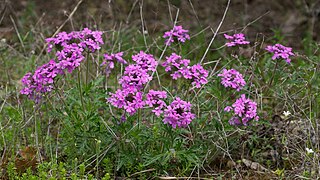
Verbena canadensis, commonly known as the rose mock vervain, rose verbena, clump verbena or rose vervain is a species of flowering plant in the verbena family (Verbenaceae). It is native to the eastern and south-central areas of the United States. This species is widely cultivated as an ornamental, and naturalized populations have been established outside its native range, such as in the northeastern U.S.

Glandularia bipinnatifida, commonly called Dakota mock vervain, prairie verbena, and Moradilla, among others, is a species of flowering plant in the verbena family (Verbenaceae).
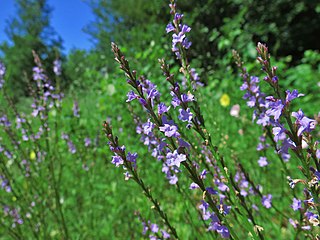
Verbena halei, commonly known as Texas vervain, Texas verbena, or slender verbena, is a flowering plant in the vervain family, Verbenaceae. It is native to much of the southern United States and Mexico. Scattered populations have been found along the east coast, and its range stretches south to Florida, west to Arizona, and throughout most of Mexico. It has been introduced to Australia, in Queensland, New South Wales, Victoria, and South Australia.
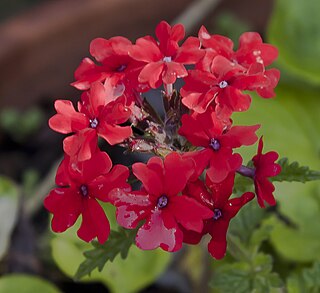
Verbena peruviana, the Peruvian mock vervain, is a species of flowering plant in the family Verbenaceae. It is native to Bolivia, southern Brazil, northern Argentina, Paraguay, and Uruguay, but not Peru, and has been introduced to scattered locations elsewhere, including the former Czechoslovakia, the US state of Illinois, and the Leeward Islands. Under the synonym Glandularia peruviana, its cultivar 'Balendpibi' has gained the Royal Horticultural Society's Award of Garden Merit.
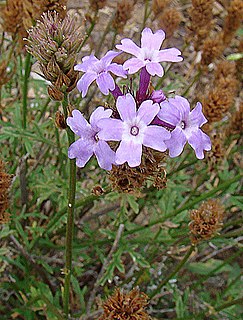
Glandularia lilacina is a species of flowering plant in the verbena family known by the common name Cedros Island verbena. It is native to Cedros Island and the adjacent Baja California coast. It is a perennial herb growing to 3 feet tall by 3 feet wide, with erect stems, narrow and elongate bipinnatifid leaves. The plant is available in multiple cultivars for gardens.

Verbena amoena is a plant species in the genus Verbena.





















